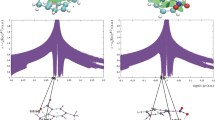Abstract
Ultraviolet spectra of 4-phenyl-[2.2]paracyclophane and of the 4,7- and 4,13-diphenyl derivatives were interpreted. MINDO/3 total molecular energy andPPP—CI-1 energies of singlet transitions were calculated for different values of the dihedral angle of the phenyl ring with respect to the benzene ring of paracyclophane. Although most of the theoretical transitions correspond to local excitation within thePCP fragment, some of them result in a transfer of electron charge to the phenyl substituents.
Zusammenfassung
Es werden die UV-Spektren von 4-Phenyl-[2.2]paracyclophan, 4,7- und 4,13-Diphenyl-[2.2]paracyclophan interpretiert. Für verschiedene Diederwinkel der Phenylringe relativ zu dem Benzolring des Paracyclophans wurden MINDO/3-Rechnungen für die Gesamtenergie undPPP—CI-1 Rechnungen für die Singlet-Übergänge durchgeführt. Die meisten der berechneten Übergänge gehören zu lokalen Anregungen innerhalb desPCP-Fragments, einige sind jedoch einem Elektronentransfer zu den Phenylsubstituenten zuzuschreiben.
Similar content being viewed by others
References
Zemanek A., Ph.D. Thesis, Silesian University, Katowice, 1981.
Zemanek A.,Czuchajowski L., Pol. J. Chem., in print.
Czuchajowski L., Pietrzycki W., J. Mol. Struct.47, 423 (1978).
Vala M. T., Jr., Hillier I. H., Rice S. A., Jortner J., J. Chem. Phys.44, 23 (1966).
Iwata S., Fuke K., Sasaki M., Nagakura S., Otsubo T., Mizumi S., J. Mol. Spectr.46, 1 (1973).
Cram D. J., Steinberg H., J. Amer. Chem. Soc.73, 5691 (1951).
Cram D. J., Steinberg H., Allinger N. L., J. Amer. Chem. Soc.76, 3132 (1954).
Czuchajowski L., Wisor A. K., Maslankiewicz M. J., Monatsh. Chem.112, 1175 (1981).
Maslankiewicz M. J., Czuchajowski L., Bull. Acad. Polon. Sci. ser. sci. chim.27, 167 (1979).
Maslankiewicz M. J., Czuchajowski L., Bull. Acad. Polon. Sci. ser. sci. chim.28, 529 (1980).
Beveridge D. L., Hinze J., J. Amer. Chem. Soc.93, 3107 (1971).
Vogler H., Theoret. Chim. Acta (Berl.)60, 65 (1981).
Alemenningen A.,Bastiansen O., K. Nor. Vidensk. Selsk. Skr. 1958, p. 4.
Brown C. J., J. Chem. Soc.1953, 3365.
Lonsdale K., Milledge J. H., Krishna Rao K. V., Proc. Roy. Soc. (London)A255, 82 (1960).
Ohta T., Kuroda H., Kunii T. L., Theor. Chim. Acta19, 167 (1970).
Author information
Authors and Affiliations
Rights and permissions
About this article
Cite this article
Wisor, A.K., Czuchajowski, L. Electronic spectra and conformational states of mono- and diphenyl derivatives of [2.2]paracyclophane. Monatsh Chem 114, 1023–1034 (1983). https://doi.org/10.1007/BF00799026
Received:
Accepted:
Issue Date:
DOI: https://doi.org/10.1007/BF00799026



